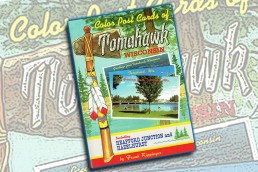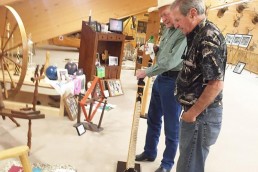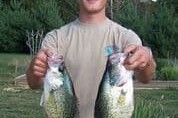Fishing History, June 2015
SHARE THIS POST
New Book: Color Post Cards of Tomahawk, Wisconsin:
Who is a collector and why? Some of us are born to collect; acquiring, keeping, arranging, displaying and caring for items we like from an early age.
If we’re lucky, we develop a passion for certain items depending on our financial situations and priorities. Some have primary collections that contain costly items that others can’t acquire because of different budgets. Many have found that, in addition to our primary interests like decoys or lures, people also collect items that others overlook that can be obtained at little cost.
Frank Rippinger, the author of the book, Color Post Cards of Tomahawk, Wisconsin, had an interesting initiation into collecting. In 1975, he saw an ad in Fishing Facts magazine that featured “The Lure that caught the World Record Bass;” the Creek Chub Bait Company’s Wigglefish. (Later we found that another Creek Chub lure—their Fintail Shiner—was the bait that actually caught that fish.)
He rushed to local tackle shops, but he couldn’t find that lure. He did, however, purchase many other Creek Chub and old musky lures from their old stock. In desperation, he wrote to Harry Heinzerling, Creek Chub Bait Company’s President, who graciously helped Frank with a Wigglefish. Frank has since been hooked on collecting and becoming a student of their products.
In 1983, while attending the Chicagoland Sportfishing Travel & Outdoors Show in Rosemont, Frank visited my Historical Fishing Display and me. He was shocked to learn there were others that shared his passion for collecting old lures and tackle. We introduced him to the National Fishing Lure Collector’s Club and he’s been a contributing member ever since.
Over the years, many of the Creek Chub lures he desired became expensive. It was time to get serious about collecting less costly items he also had a passion for.
From 1969, whenever his family went up north for their summer vacation, 10-year-old Frank was transfixed as they entered the town of Tomahawk, Wisconsin. He saw all kinds of signs by the Chamber of Commerce log cabin, the Totem Poles, the Tomahawk Hotel, Tomahawk Boats, the Indian Chief on Nelson’s Market, tackle shops and resorts. He gathered all of the brochures and post cards he could on each subsequent visit and that others might have found.
Are you enjoying this post?
You can be among the first to get the latest info on where to go, what to use and how to use it!
Early history reveals the Ojibwa, who actively traded furs through the 1837 cession, occupied this land. This agreement ceded to the United States land between the Mississippi and Wisconsin Rivers, Lake Superior and the “Prarie du Chein Line.” It guaranteed access to lumber resources with payments to the signatory bands and usufructuary rights to continue hunting, fishing and gathering within the treaty ceeded territory.
Logging activity surged after the Civil War for housing in the Midwest. Construction camps—for crews building one of the world’s largest dams and a railroad—began forming in 1886. They are credited with the early growth of Tomahawk, which was incorporated in 1891.
Frank’s love for this area is experienced in musky fishing trips each year. He collects, researches and shares his finds of paper items from the area. Frank lives vicariously the years of the area and its eras through colorful illustrations and writings.
Rippinger has always been happy to share his knowledge of lures. Now he wants others to enjoy his passion for the Wisconsin fishing scene and the post cards of a wonderful era through his new book.
Well-known artist John Boettcher, a lifetime resident of the Northwoods, created the book covers and Map Section. His works reflect the deep attachment he has to the wilderness areas and wildlife native to the area.
Only collectors will understand why Frank self-published his book. He didn’t want a bar code to sully the aura of this remembrance of a classic time in fishing history. You may order directly from Frank Rippinger, 318 N. Jefferson St., Batavia, IL 60510 for $15, plus $3 postage.
Dan Basore is a fishing historian and steward of the history of the sport. In his efforts to preserve fishing history, Basore is always on the lookout for information about early lure makers, old lures, pre-level wind reels, manufacturer catalogs, tournament casting items and the like. If you possess information or materials that can help, please contact Dan Basore, Historical Fishing Display, at 630-393-3474 or 1-800-347-4525.
MWO
SHARE THIS POST
Did you enjoy this post?
You can be among the first to get the latest info on where to go, what to use and how to use it!
Dan Basore
Dan Basore is a fishing historian and steward of the history of the sport. In his efforts to preserve fishing history, he is always on the lookout for information about early lure makers, old lures, pre-level wind reels, manufacturer catalogs, tournament casting items and the like. If you possess information or materials of this kind, please contact him at 630-393-3474 or by email at ollures@aol.com.



